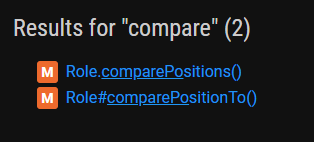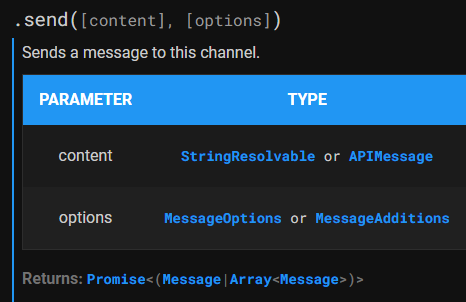# Understanding notation
Throughout the discord.js docs and when asking for help on the official server, you will run into many different kinds of notations. To help you understand the texts that you read, we will be going over some standard notations.
TIP
Always keep in mind that notation is not always rigorous. There will be typos, misunderstandings, or contexts that will cause notation to differ from the usual meanings.
# Classes
Some common notations refer to a class or the properties, methods, or events of a class. There are many variations on these notations, and they are very flexible depending on the person, so use your best judgment when reading them.
The notation <Class> means an instance of the Class class. For example, a snippet like <Message>.reply('hello') is asking you to replace <Message> with some value that is an instance of Message, e.g. msg.reply('hello'). It could also just be a placeholder, e.g., <id> would mean a placeholder for some ID.
The notation Class#foo can refer to the foo property, method, or event of the Class class. Which one the writer meant needs to be determined from context. For example:
Message#authormeans that you should refer to theauthorproperty on aMessage.TextChannel#sendmeans that you should refer to thesendmethod on aTextChannel.Client#messagemeans that you should refer to themessageevent on aClient.
TIP
Remember that this notation is not valid JavaScript; it is a shorthand to refer to a specific piece of code.
Sometimes, the notation is extended, which can help you determine which one the writer meant. For example, TextChannel#send(content, options) is definitely a method of TextChannel, since it uses function notation. Client#event:message is an event since it says it is an event.
The vital thing to take away from this notation is that the # symbol signifies that the property, method, or event can only be accessed through an instance of the class. Unfortunately, many abuse this notation, e.g., <Message>#send or Util#resolveColor. <Message> is already an instance, so this makes no sense, and resolveColor is a static method–you should write it as Util.resolveColor. Always refer back to the docs if you are confused.
As an example, the documentation's search feature uses this notation.

Notice the use of the . operator for the static method, Role.comparePositions and the # notation for the method, Role#comparePositionsTo.
# Types
In the discord.js docs, there are type signatures everywhere, such as in properties, parameters, or return values. If you do not come from a statically typed language, you may not know what specific notations mean.
The symbol * means any type. For example, methods that return * mean that they can return anything, and a parameter of type * can be anything.
The symbol ? means that the type is nullable. You can see it before or after the type (e.g. ?T or T?). This symbol means that the value can be of the type T or null. An example is GuildMember#nickname; its type is ?string since a member may or may not have a nickname.
The expression T[] means an array of T. You can sometimes see multiple brackets [], indicating that the array is multi-dimensional, e.g., string[][].
The expression ...T signifies a rest parameter of type T. This means that the function can take any amount of arguments, and all those arguments must be of the type T.
The operator |, which can read as "or", creates a union type, e.g. A|B|C. Simply, it means the value can be of any one of the types given.
The angle brackets <> are used for generic types or parameterized types, signifying a type that uses another type(s). The notation looks like A<B> where A is the type and B is a type parameter. If this is hard to follow, it is enough to keep in mind that whenever you see A<B>, you can think of an A containing B. Examples:
Array<String>means an array of strings.Promise<User>means aPromisethat contains aUser.Array<Promise<User|GuildMember>>would be an array ofPromises, each containing aUseror aGuildMember.Collection<Snowflake, User>would be aCollection, containing key-value pairs where the keys areSnowflakes, and the values areUsers.

In this piece of the docs, you can see three type signatures, StringResolvable or APIMessage, MessageOptions or MessageAdditions, and Promise<(Message|Array<Message>)>. The meaning of the word "or" here is the same as |.